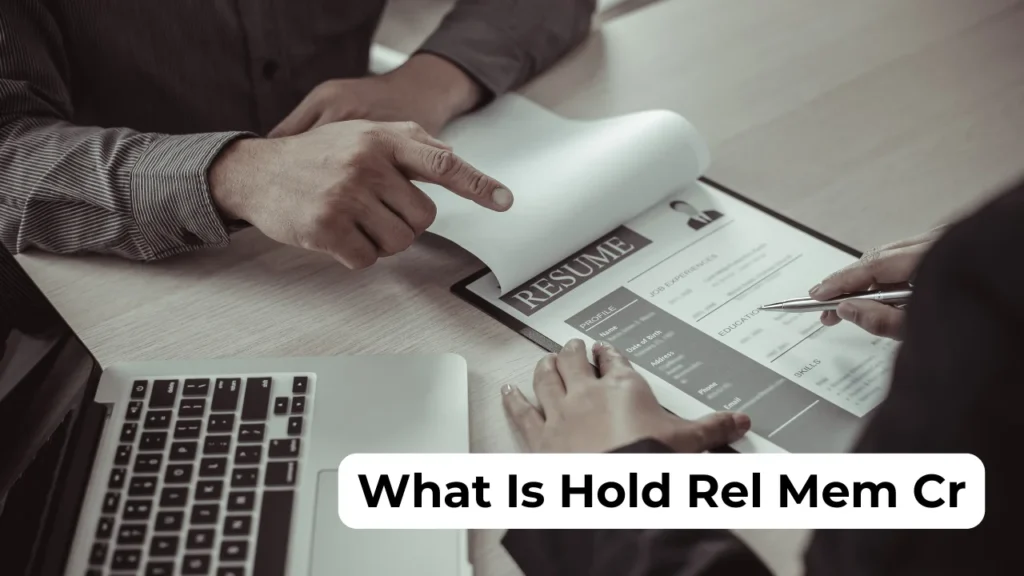You’ve probably checked your bank account and noticed a mysterious “hold rel mem cr” or “memo debit” entry. It’s confusing, right? Maybe you deposited a check, only to see your funds stuck in limbo. Or perhaps a transaction is labeled “on hold,” leaving you wondering why you can’t access your money. Don’t worry—you’re not alone. Bank holds, like those from Chase, spark countless questions online, from Reddit threads to Google searches. In this guide, I’ll break down what “hold rel mem cr” means, why banks use holds, and how you can navigate them. Let’s clear the fog and get your banking questions answered.
What Is Hold Rel Mem Cr

The term “hold rel mem cr” pops up in banking, especially with Chase, but it’s not exactly user-friendly. It’s shorthand for a hold, release, memo, or credit on your account. Understanding it requires unpacking how banks process transactions. Let’s dive into the details with clear explanations to help you make sense of this jargon.
Breaking Down the Term
“Hold rel mem cr” stands for “hold released memo credit.” It’s a temporary status in your account when a bank places or removes a hold on funds. A memo credit is a placeholder, showing funds that aren’t fully cleared yet. Chase uses this to track transactions like deposits or payments.
Why You See It
You might notice this after depositing a check or making a large purchase. The bank flags the transaction to verify it, ensuring the funds are legit. It’s like a security checkpoint for your money. This can feel frustrating, but it protects both you and the bank from fraud.
How It Affects Your Balance
When a hold is active, your available balance might differ from your total balance. For example, a $500 check deposit could show as “pending” with a hold. You can’t spend that money until the hold lifts. Once released, the “mem cr” updates to reflect cleared funds.
Common Scenarios
This term often appears with check deposits, wire transfers, or large transactions. On Reddit, users share stories of seeing “hold rel mem cr” after depositing a paycheck, only to wait days for access. It’s a standard banking practice, but the lack of clarity can spark confusion.
Why Banks Place Holds
Ever wondered, “Why did Chase put my deposit on hold?” Banks don’t just freeze your money for fun—it’s about risk management. Holds are a safety net, but they can catch you off guard. Let’s explore the main reasons banks like Chase use holds and what triggers them.
Preventing Fraud
Banks place holds to verify transactions. If you deposit a large check, they need to ensure it won’t bounce. Fraudsters often use fake checks, so Chase might hold funds until the check clears. This protects the bank and keeps your account secure.
Large or Unusual Deposits
A sudden $10,000 deposit in your account raises red flags. Chase might place a hold to confirm the source. On Reddit, users often ask, “Why is my bank transaction on hold?” The answer is usually the bank’s caution with unfamiliar or high-value deposits.
New Accounts
If you just opened a Chase account, expect stricter hold policies. Banks are extra careful with new customers because they lack transaction history. A hold on your first few deposits is common, often lasting 2–7 days, depending on the amount.
Deposited Item Issues
Sometimes, a deposited item, like a check, is returned unpaid. Chase might label this as “deposited item returned,” placing a hold until resolved. This happens if the payer’s account lacks funds or the check is flagged for errors.
Regulatory Requirements
Federal laws, like Regulation CC, govern how banks handle deposits. Chase must follow rules on fund availability, which can lead to holds on certain transactions. For example, large deposits over $5,000 often face extended holds to comply with these regulations.
Table: Common Reasons for Bank Holds
| Reason | Description | Typical Hold Duration |
| Fraud Prevention | Verifying check or transaction legitimacy | 2–7 days |
| Large Deposits | Holds on deposits over $5,000 | 5–10 days |
| New Accounts | Extra scrutiny for new customers | 3–7 days |
| Returned Items | Holds due to bounced checks or errors | Until resolved |
| Regulatory Compliance | Following federal laws like Regulation CC | Varies by transaction |
How Chase Handles Holds
Chase, like other banks, has specific policies for holds, memo debits, and credits. If you’ve seen “hold memo dr Chase meaning” in your statement, it’s tied to their transaction processing. Let’s look at how Chase manages holds and what you can expect.
Chase Hold Policies
Chase places holds based on deposit type, account history, and transaction size. Checks from new accounts or out-of-state banks often face longer holds. Their policy aligns with federal guidelines, but Chase may extend holds for high-risk transactions to minimize fraud.
Memo Debit vs. Memo Credit
A memo debit (hold memo dr) temporarily reduces your available balance, like when you swipe your card at a gas station. A memo credit, like “hold rel mem cr,” shows funds pending clearance, such as a deposited check. Both are temporary until the transaction finalizes.
Hold Duration
Most holds last 2–7 days, but large deposits or returned items can take longer. Chase’s app or statements often show “hold rel mem cr but funds are available” once the hold lifts. If funds still aren’t accessible, it might be due to processing delays or verification.
Customer Complaints
Reddit threads, like those asking “What is memo debit Chase reddit,” reveal frustration with unclear hold terms. Users report seeing holds despite available funds, often due to miscommunication. Checking your account status online or calling Chase can clarify these issues.
In my experience, contacting Chase directly cuts through the confusion. I once had a hold on a $2,000 check deposit, and a quick call to their support team explained it was due to an out-of-state issuer. They released it the next day.
How to Remove a Hold
Nobody likes waiting for their money. If you’re asking, “How to remove a hold on bank account,” there are steps you can take. While some holds are non-negotiable, others can be resolved faster with the right approach. Here’s how to tackle it.
Contact Chase Support
Call Chase’s customer service at 1-800-935-9935 or visit a branch. Explain your situation, like a “hold rel mem cr” notice, and ask for details. Provide transaction info, such as deposit amount or date, to speed things up. They might lift the hold early if verified.
Verify the Deposit
If the hold is on a check, confirm the payer has sufficient funds. Share proof, like a bank statement, with Chase. For wire transfers, provide sender details. Quick verification can shorten the hold, especially for large or unusual deposits.
Check Account Status
New accounts or those with frequent overdrafts face stricter holds. Ensure your account is in good standing—no negative balances or pending disputes. If you’re a long-time customer, mention your history; Chase may expedite the release for loyal clients.
Escalate if Needed
If the hold persists, ask to speak with a supervisor. Be polite but firm. On Reddit, users share success stories of resolving “hold rel mem cr charges” by escalating issues. Document all communication, including dates and names, for reference.
Avoid Future Holds
To prevent holds, use direct deposits or electronic transfers, which clear faster than checks. Stick to in-network ATMs and avoid large, irregular deposits. Building a solid account history with Chase reduces hold frequency over time.
Table: Steps to Remove a Bank Hold
| Step | Action | Expected Outcome |
| Contact Chase | Call or visit a branch with transaction details | Clarify hold reason |
| Verify Deposit | Provide proof of funds or sender info | Faster hold release |
| Check Account | Ensure no overdrafts or disputes | Reduced hold scrutiny |
| Escalate Issue | Speak to a supervisor if unresolved | Potential hold removal |
What I learned the hard way is that patience pays off, but persistence is key. I once waited a week for a hold to lift, only to learn a quick call could’ve cut it to two days. Always follow up.
Actionable Tips for Managing Holds
Dealing with bank holds can feel like a hassle, but you can take control. Here are five actionable tips to manage or avoid holds like “hold rel mem cr”:
- Check your account daily: Use Chase’s app to spot holds early and track “hold rel mem cr” statuses.
- Ask for faster clearance: When depositing checks, request same-day availability at the branch.
- Use direct deposits: They clear quicker than checks, reducing hold risks.
- Build account history: Consistent banking with Chase lowers hold frequency.
- Keep records: Save deposit receipts or transaction IDs to resolve disputes faster.
FAQs About Hold Rel Mem Cr
What does hold memo mean for banks?
A hold memo, like “hold rel mem cr,” is a temporary restriction on funds. Banks use it to verify deposits or transactions, ensuring they’re legitimate before releasing the money.
Why is my bank transaction on hold?
Your transaction might be on hold due to fraud checks, large deposits, or account issues. Chase often holds funds to confirm the payer has sufficient funds or to comply with regulations.
How long does a Chase hold last?
Most Chase holds last 2–7 days. Large deposits or returned items may take up to 10 days. Check your account or contact Chase for specifics.
Can I remove a hold on my account?
Yes, you can try to remove a hold by contacting Chase, verifying the deposit, or escalating the issue. Success depends on the hold’s reason and your account status.
What is a memo debit Chase reddit?
A memo debit is a temporary charge reducing your available balance, often for pending transactions. Reddit users note it appears during holds, like gas station swipes.
Why was my deposited item returned?
A deposited item, like a check, is returned if the payer’s account lacks funds or the check is invalid. Chase may place a hold until resolved.
Also Read: André Hakkak: A Visionary Leader in Alternative Investment and SME Financing
Conclusion
Navigating “hold rel mem cr” and other bank holds can be a headache, but it’s manageable with the right knowledge. These holds, common with Chase, protect against fraud and ensure compliance, but they can delay access to your money. By understanding why holds happen, how Chase processes them, and steps to resolve them, you’re better equipped to handle banking hiccups. Check your account regularly, contact Chase when needed, and use direct deposits to minimize holds. Here’s a tip I always give beginners: Stay proactive—monitor your transactions and don’t hesitate to ask questions. Your money, your rules.

Lois Snyder is a versatile writer with experience across multiple domains. She crafts engaging and informative content, delivering valuable insights and captivating readers with her expertise and passion for diverse topics.
